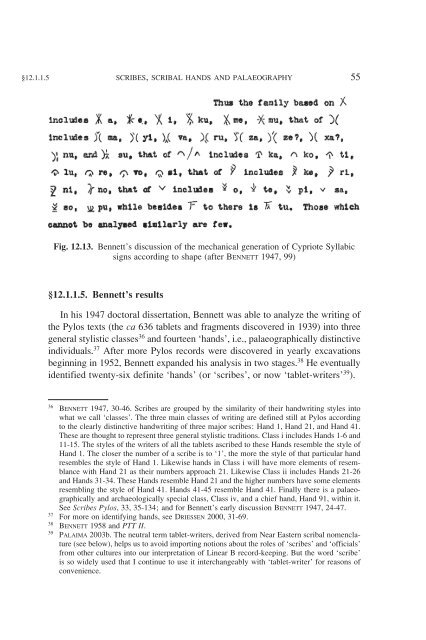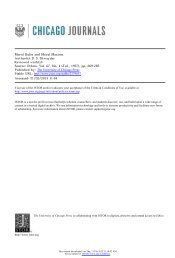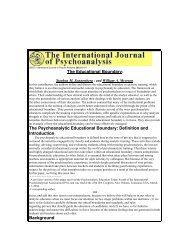A Companion to Linear B - The University of Texas at Austin
A Companion to Linear B - The University of Texas at Austin
A Companion to Linear B - The University of Texas at Austin
Create successful ePaper yourself
Turn your PDF publications into a flip-book with our unique Google optimized e-Paper software.
§12.1.1.5 SCRIBES, SCRIBAL HANDS AND PALAEOGRAPHY 55<br />
Fig. 12.13. Bennett’s discussion <strong>of</strong> the mechanical gener<strong>at</strong>ion <strong>of</strong> Cypriote Syllabic<br />
signs according <strong>to</strong> shape (after BENNETT 1947, 99)<br />
§12.1.1.5. Bennett’s results<br />
In his 1947 doc<strong>to</strong>ral dissert<strong>at</strong>ion, Bennett was able <strong>to</strong> analyze the writing <strong>of</strong><br />
the Pylos texts (the ca 636 tablets and fragments discovered in 1939) in<strong>to</strong> three<br />
general stylistic classes 36 and fourteen ‘hands’, i.e., palaeographically distinctive<br />
individuals. 37 After more Pylos records were discovered in yearly excav<strong>at</strong>ions<br />
beginning in 1952, Bennett expanded his analysis in two stages. 38 He eventually<br />
identified twenty-six definite ‘hands’ (or ‘scribes’, or now ‘tablet-writers’ 39 ).<br />
36 BENNETT 1947, 30-46. Scribes are grouped by the similarity <strong>of</strong> their handwriting styles in<strong>to</strong><br />
wh<strong>at</strong> we call ‘classes’. <strong>The</strong> three main classes <strong>of</strong> writing are defined still <strong>at</strong> Pylos according<br />
<strong>to</strong> the clearly distinctive handwriting <strong>of</strong> three major scribes: Hand 1, Hand 21, and Hand 41.<br />
<strong>The</strong>se are thought <strong>to</strong> represent three general stylistic traditions. Class i includes Hands 1-6 and<br />
11-15. <strong>The</strong> styles <strong>of</strong> the writers <strong>of</strong> all the tablets ascribed <strong>to</strong> these Hands resemble the style <strong>of</strong><br />
Hand 1. <strong>The</strong> closer the number <strong>of</strong> a scribe is <strong>to</strong> ‘1’, the more the style <strong>of</strong> th<strong>at</strong> particular hand<br />
resembles the style <strong>of</strong> Hand 1. Likewise hands in Class i will have more elements <strong>of</strong> resemblance<br />
with Hand 21 as their numbers approach 21. Likewise Class ii includes Hands 21-26<br />
and Hands 31-34. <strong>The</strong>se Hands resemble Hand 21 and the higher numbers have some elements<br />
resembling the style <strong>of</strong> Hand 41. Hands 41-45 resemble Hand 41. Finally there is a palaeographically<br />
and archaeologically special class, Class iv, and a chief hand, Hand 91, within it.<br />
See Scribes Pylos, 33, 35-134; and for Bennett’s early discussion BENNETT 1947, 24-47.<br />
37 For more on identifying hands, see DRIESSEN 2000, 31-69.<br />
38 BENNETT 1958 and PTT II.<br />
39 PALAIMA 2003b. <strong>The</strong> neutral term tablet-writers, derived from Near Eastern scribal nomencl<strong>at</strong>ure<br />
(see below), helps us <strong>to</strong> avoid importing notions about the roles <strong>of</strong> ‘scribes’ and ‘<strong>of</strong>ficials’<br />
from other cultures in<strong>to</strong> our interpret<strong>at</strong>ion <strong>of</strong> <strong>Linear</strong> B record-keeping. But the word ‘scribe’<br />
is so widely used th<strong>at</strong> I continue <strong>to</strong> use it interchangeably with ‘tablet-writer’ for reasons <strong>of</strong><br />
convenience.

















